Dong Han
KAN See Your Face
Nov 27, 2024Abstract:With the advancement of face reconstruction (FR) systems, privacy-preserving face recognition (PPFR) has gained popularity for its secure face recognition, enhanced facial privacy protection, and robustness to various attacks. Besides, specific models and algorithms are proposed for face embedding protection by mapping embeddings to a secure space. However, there is a lack of studies on investigating and evaluating the possibility of extracting face images from embeddings of those systems, especially for PPFR. In this work, we introduce the first approach to exploit Kolmogorov-Arnold Network (KAN) for conducting embedding-to-face attacks against state-of-the-art (SOTA) FR and PPFR systems. Face embedding mapping (FEM) models are proposed to learn the distribution mapping relation between the embeddings from the initial domain and target domain. In comparison with Multi-Layer Perceptrons (MLP), we provide two variants, FEM-KAN and FEM-MLP, for efficient non-linear embedding-to-embedding mapping in order to reconstruct realistic face images from the corresponding face embedding. To verify our methods, we conduct extensive experiments with various PPFR and FR models. We also measure reconstructed face images with different metrics to evaluate the image quality. Through comprehensive experiments, we demonstrate the effectiveness of FEMs in accurate embedding mapping and face reconstruction.
ShieldDiff: Suppressing Sexual Content Generation from Diffusion Models through Reinforcement Learning
Oct 04, 2024



Abstract:With the advance of generative AI, the text-to-image (T2I) model has the ability to generate various contents. However, the generated contents cannot be fully controlled. There is a potential risk that T2I model can generate unsafe images with uncomfortable contents. In our work, we focus on eliminating the NSFW (not safe for work) content generation from T2I model while maintaining the high quality of generated images by fine-tuning the pre-trained diffusion model via reinforcement learning by optimizing the well-designed content-safe reward function. The proposed method leverages a customized reward function consisting of the CLIP (Contrastive Language-Image Pre-training) and nudity rewards to prune the nudity contents that adhere to the pret-rained model and keep the corresponding semantic meaning on the safe side. In this way, the T2I model is robust to unsafe adversarial prompts since unsafe visual representations are mitigated from latent space. Extensive experiments conducted on different datasets demonstrate the effectiveness of the proposed method in alleviating unsafe content generation while preserving the high-fidelity of benign images as well as images generated by unsafe prompts. We compare with five existing state-of-the-art (SOTA) methods and achieve competitive performance on sexual content removal and image quality retention. In terms of robustness, our method outperforms counterparts under the SOTA black-box attacking model. Furthermore, our constructed method can be a benchmark for anti-NSFW generation with semantically-relevant safe alignment.
Fusion is all you need: Face Fusion for Customized Identity-Preserving Image Synthesis
Sep 27, 2024Abstract:Text-to-image (T2I) models have significantly advanced the development of artificial intelligence, enabling the generation of high-quality images in diverse contexts based on specific text prompts. However, existing T2I-based methods often struggle to accurately reproduce the appearance of individuals from a reference image and to create novel representations of those individuals in various settings. To address this, we leverage the pre-trained UNet from Stable Diffusion to incorporate the target face image directly into the generation process. Our approach diverges from prior methods that depend on fixed encoders or static face embeddings, which often fail to bridge encoding gaps. Instead, we capitalize on UNet's sophisticated encoding capabilities to process reference images across multiple scales. By innovatively altering the cross-attention layers of the UNet, we effectively fuse individual identities into the generative process. This strategic integration of facial features across various scales not only enhances the robustness and consistency of the generated images but also facilitates efficient multi-reference and multi-identity generation. Our method sets a new benchmark in identity-preserving image generation, delivering state-of-the-art results in similarity metrics while maintaining prompt alignment.
Multiclass Arrhythmia Classification using Smartwatch Photoplethysmography Signals Collected in Real-life Settings
Sep 10, 2024Abstract:Most deep learning models of multiclass arrhythmia classification are tested on fingertip photoplethysmographic (PPG) data, which has higher signal-to-noise ratios compared to smartwatch-derived PPG, and the best reported sensitivity value for premature atrial/ventricular contraction (PAC/PVC) detection is only 75%. To improve upon PAC/PVC detection sensitivity while maintaining high AF detection, we use multi-modal data which incorporates 1D PPG, accelerometers, and heart rate data as the inputs to a computationally efficient 1D bi-directional Gated Recurrent Unit (1D-Bi-GRU) model to detect three arrhythmia classes. We used motion-artifact prone smartwatch PPG data from the NIH-funded Pulsewatch clinical trial. Our multimodal model tested on 72 subjects achieved an unprecedented 83% sensitivity for PAC/PVC detection while maintaining a high accuracy of 97.31% for AF detection. These results outperformed the best state-of-the-art model by 20.81% for PAC/PVC and 2.55% for AF detection even while our model was computationally more efficient (14 times lighter and 2.7 faster).
Robust Skin Color Driven Privacy Preserving Face Recognition via Function Secret Sharing
Jul 06, 2024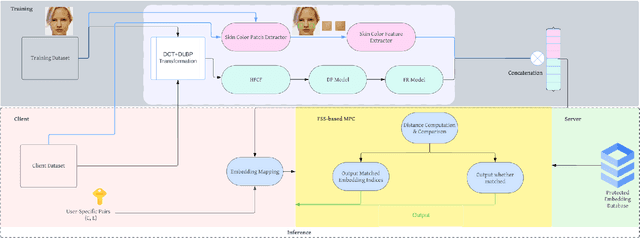

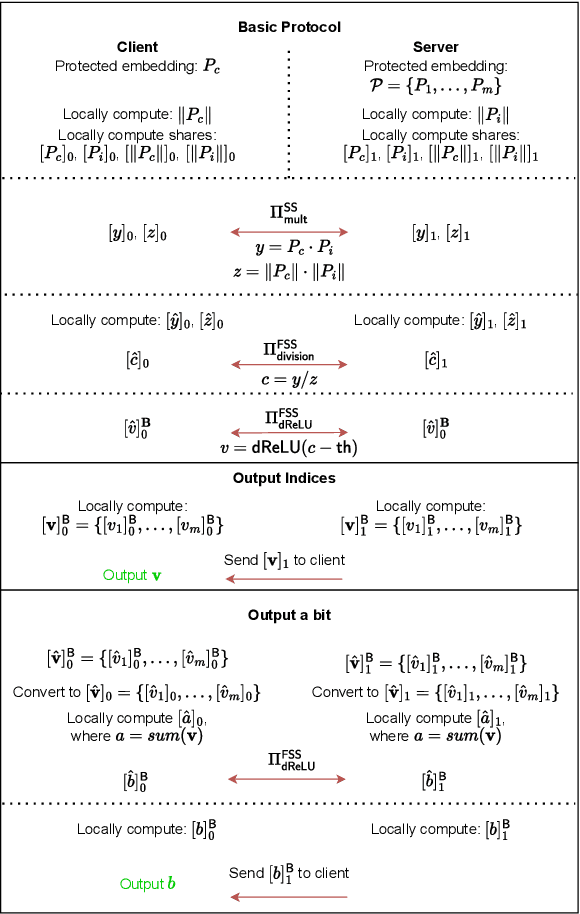

Abstract:In this work, we leverage the pure skin color patch from the face image as the additional information to train an auxiliary skin color feature extractor and face recognition model in parallel to improve performance of state-of-the-art (SOTA) privacy-preserving face recognition (PPFR) systems. Our solution is robust against black-box attacking and well-established generative adversarial network (GAN) based image restoration. We analyze the potential risk in previous work, where the proposed cosine similarity computation might directly leak the protected precomputed embedding stored on the server side. We propose a Function Secret Sharing (FSS) based face embedding comparison protocol without any intermediate result leakage. In addition, we show in experiments that the proposed protocol is more efficient compared to the Secret Sharing (SS) based protocol.
Unleashing Generalization of End-to-End Autonomous Driving with Controllable Long Video Generation
Jun 03, 2024Abstract:Using generative models to synthesize new data has become a de-facto standard in autonomous driving to address the data scarcity issue. Though existing approaches are able to boost perception models, we discover that these approaches fail to improve the performance of planning of end-to-end autonomous driving models as the generated videos are usually less than 8 frames and the spatial and temporal inconsistencies are not negligible. To this end, we propose Delphi, a novel diffusion-based long video generation method with a shared noise modeling mechanism across the multi-views to increase spatial consistency, and a feature-aligned module to achieves both precise controllability and temporal consistency. Our method can generate up to 40 frames of video without loss of consistency which is about 5 times longer compared with state-of-the-art methods. Instead of randomly generating new data, we further design a sampling policy to let Delphi generate new data that are similar to those failure cases to improve the sample efficiency. This is achieved by building a failure-case driven framework with the help of pre-trained visual language models. Our extensive experiment demonstrates that our Delphi generates a higher quality of long videos surpassing previous state-of-the-art methods. Consequentially, with only generating 4% of the training dataset size, our framework is able to go beyond perception and prediction tasks, for the first time to the best of our knowledge, boost the planning performance of the end-to-end autonomous driving model by a margin of 25%.
Privacy-Preserving Face Recognition in Hybrid Frequency-Color Domain
Jan 24, 2024



Abstract:Face recognition technology has been deployed in various real-life applications. The most sophisticated deep learning-based face recognition systems rely on training millions of face images through complex deep neural networks to achieve high accuracy. It is quite common for clients to upload face images to the service provider in order to access the model inference. However, the face image is a type of sensitive biometric attribute tied to the identity information of each user. Directly exposing the raw face image to the service provider poses a threat to the user's privacy. Current privacy-preserving approaches to face recognition focus on either concealing visual information on model input or protecting model output face embedding. The noticeable drop in recognition accuracy is a pitfall for most methods. This paper proposes a hybrid frequency-color fusion approach to reduce the input dimensionality of face recognition in the frequency domain. Moreover, sparse color information is also introduced to alleviate significant accuracy degradation after adding differential privacy noise. Besides, an identity-specific embedding mapping scheme is applied to protect original face embedding by enlarging the distance among identities. Lastly, secure multiparty computation is implemented for safely computing the embedding distance during model inference. The proposed method performs well on multiple widely used verification datasets. Moreover, it has around 2.6% to 4.2% higher accuracy than the state-of-the-art in the 1:N verification scenario.
Hercules: An Autonomous Logistic Vehicle for Contact-less Goods Transportation During the COVID-19 Outbreak
Apr 16, 2020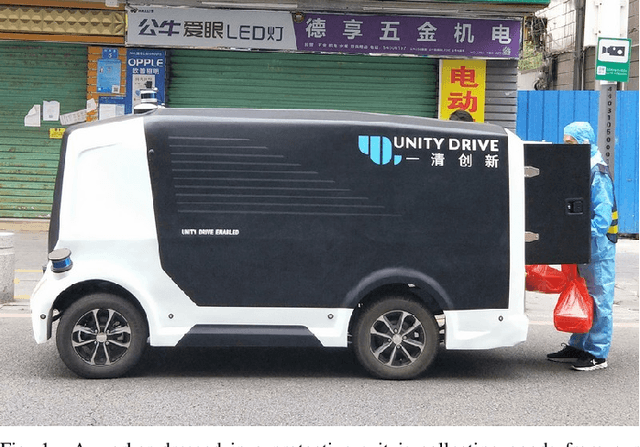
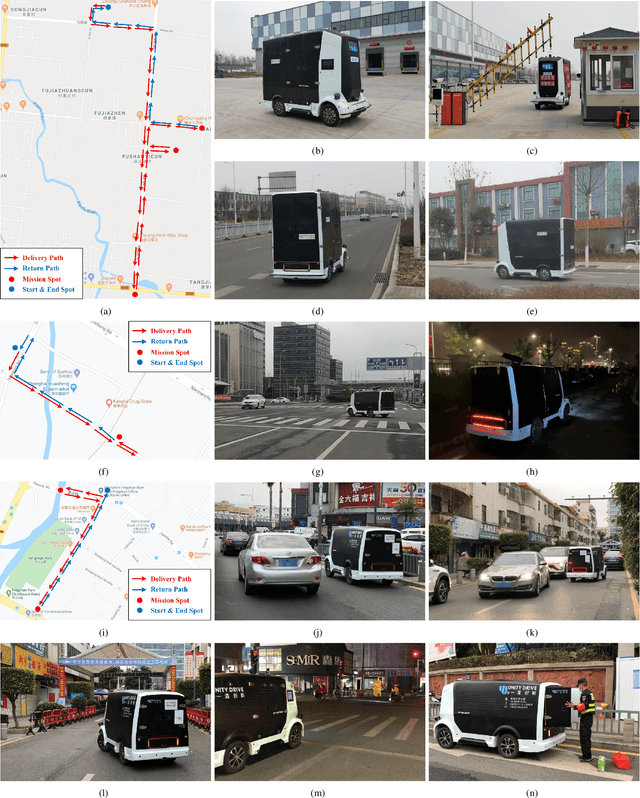
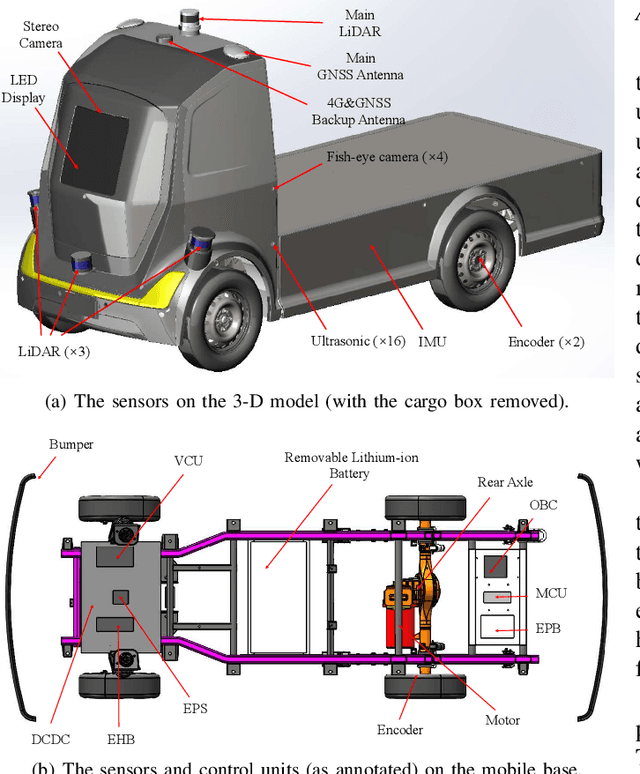
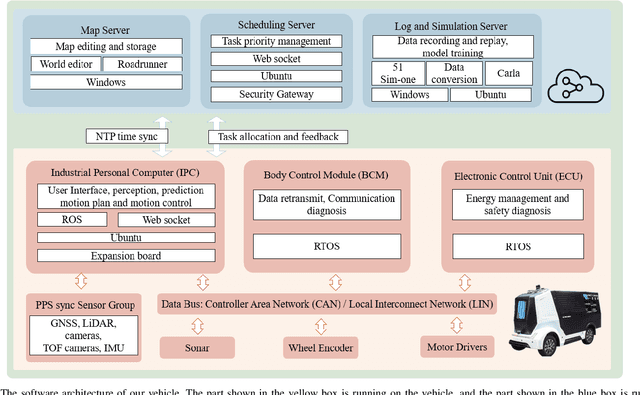
Abstract:Since December 2019, the coronavirus disease 2019 (COVID-19) has spread rapidly across China. As at the date of writing this article, the disease has been globally reported in 100 countries, infected over 100,000 people and caused over 3,000 deaths. Avoiding person-to-person transmission is an effective approach to control and prevent the epidemic. However, many daily activities, such as logistics transporting goods in our daily life, inevitably involve person-to-person contact. To achieve contact-less goods transportation, using an autonomous logistic vehicle has become the preferred choice. This article presents Hercules, an autonomous logistic vehicle used for contact-less goods transportation during the outbreak of COVID-19. The vehicle is designed with autonomous navigation capability. We provide details on the hardware and software, as well as the algorithms to achieve autonomous navigation including perception, planning and control. This paper is accompanied by a demonstration video and a dataset, which are available here: https://sites.google.com/view/contact-less-transportation.
A Robust Stereo Camera Localization Method with Prior LiDAR Map Constrains
Dec 02, 2019
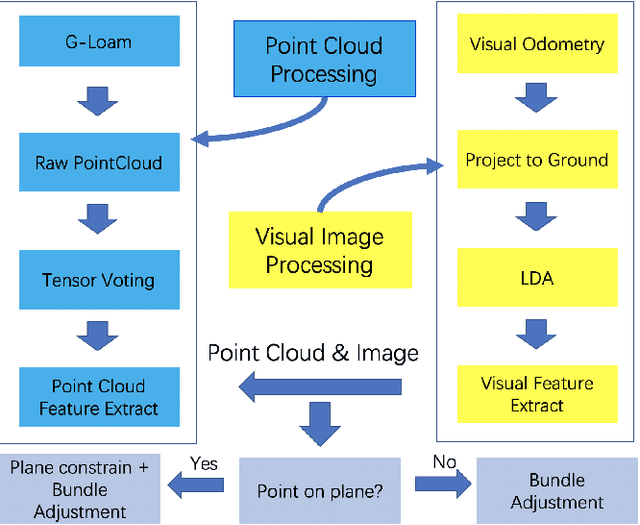


Abstract:In complex environments, low-cost and robust localization is a challenging problem. For example, in a GPSdenied environment, LiDAR can provide accurate position information, but the cost is high. In general, visual SLAM based localization methods become unreliable when the sunlight changes greatly. Therefore, inexpensive and reliable methods are required. In this paper, we propose a stereo visual localization method based on the prior LiDAR map. Different from the conventional visual localization system, we design a novel visual optimization model by matching planar information between the LiDAR map and visual image. Bundle adjustment is built by using coplanarity constraints. To solve the optimization problem, we use a graph-based optimization algorithm and a local window optimization method. Finally, we estimate a full six degrees of freedom (DOF) pose without scale drift. To validate the efficiency, the proposed method has been tested on the KITTI dataset. The results show that our method is more robust and accurate than the state-of-art ORB-SLAM2.
Road Curb Detection Using A Novel Tensor Voting Algorithm
Nov 29, 2019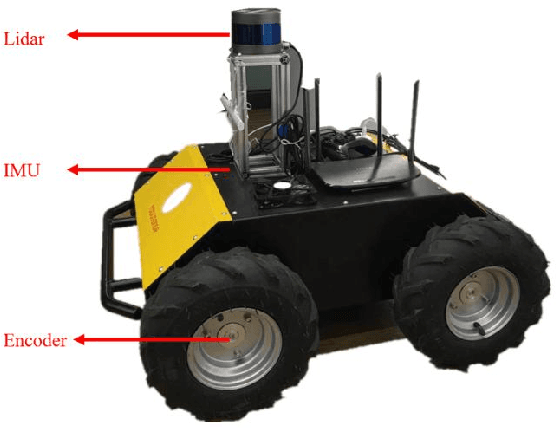
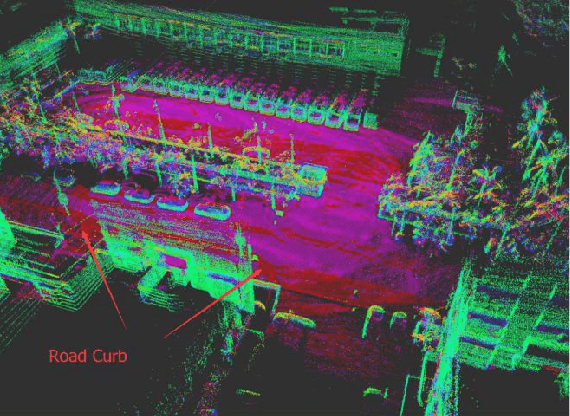
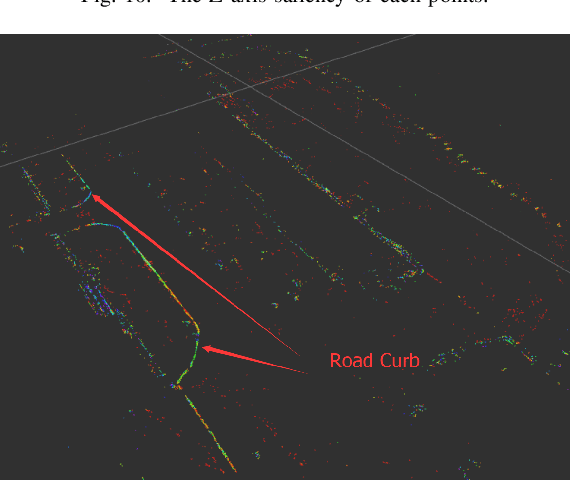
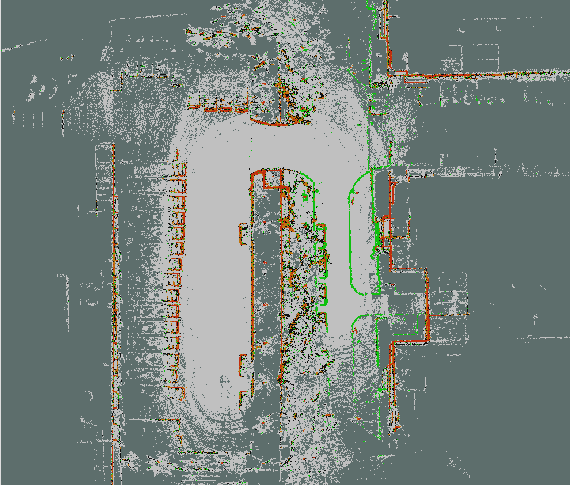
Abstract:Road curb detection is very important and necessary for autonomous driving because it can improve the safety and robustness of robot navigation in the outdoor environment. In this paper, a novel road curb detection method based on tensor voting is presented. The proposed method processes the dense point cloud acquired using a 3D LiDAR. Firstly, we utilize a sparse tensor voting approach to extract the line and surface features. Then, we use an adaptive height threshold and a surface vector to extract the point clouds of the road curbs. Finally, we utilize the height threshold to segment different obstacles from the occupancy grid map. This also provides an effective way of generating high-definition maps. The experimental results illustrate that our proposed algorithm can detect road curbs with near real-time performance.
 Add to Chrome
Add to Chrome Add to Firefox
Add to Firefox Add to Edge
Add to Edge